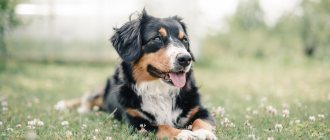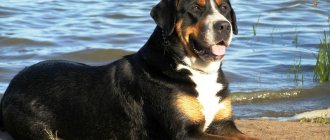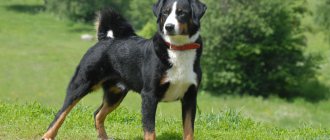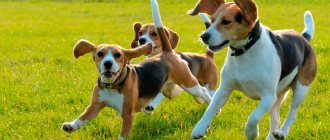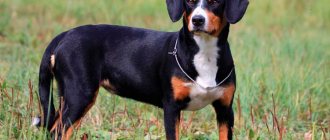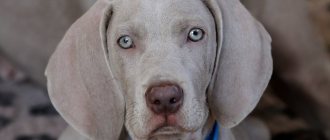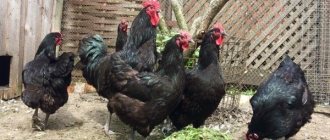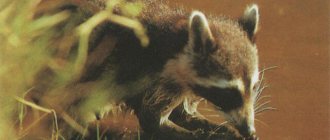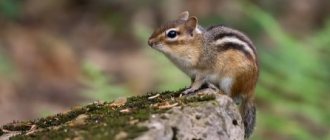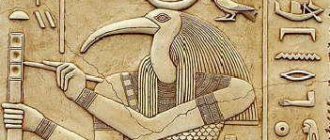The Bernese Mountain Dog is a friendly, calm and responsible dog that has a rare quality: it can show emotions. Because of this, representatives of the breed often appear in films and television series. Many people remember the smart and lucky dog Baron from the series “Happy Together” and the puppy from the film “Equilibrium”, who managed to touch the heart of the deprived protagonist. Let's find out what other qualities this breed has.
Story
The literal translation of the name “Bernese Mountain Dog” is “a dog from the Alpine meadows.” Indeed, this breed was known in the Swiss mountains back in the first century AD - it was then that the Romans brought their dogs - huge Molossians - to Helvetia. Some of them were lost and, as a result of crossing with other breeds - Great Danes and the Central European Great Dane - the Mountain Dogs appeared. Swiss peasants quickly appreciated this breed - the dogs were both strong and friendly - and began to breed them to help with housework.
Bernese Mountain Dogs have taken root on Swiss farms. They helped herd and guard livestock. A large, fluffy and friendly dog did not scare the sheep and at the same time could give a proper rebuff to predators. Sennenhunds were often used as guard dogs; they guarded yards. These animals were also used as heavy haulers: the Sennenhund could easily pull a cart.
The breed began to be purposefully bred in 1892, when winemaker F. Shertenleib bought several animals and began crossing them with each other. The FCI officially recognized the breed in 1993.
Currently, Mountain Dogs work in mountain rescue teams, but more often they are kept as companions and pets.
General characteristics of the Bernese Mountain Dog breed
Bernese Mountain Dogs are also called Bernese Shepherds or Bernese Cattle Dogs, or Bernese for short. This ancient breed, known since the 1st century AD. e., at first it was called Dürbechler, from the city of Dürbach, where it was especially widespread. The word zennenhund is translated from German as “herding dog.”
Now the breed is popular not only in its homeland because of the attractive appearance and amazing character of these dogs. They are used in search and rescue services, the police, and can transport cargo. The Bernese Mountain Dog is an excellent companion for families with children, patient, calm and obedient.
| Options | Characteristic |
| Name | Bernese Mountain Dog (German: Berner Sennenhund) |
| a country | Switzerland |
| group of breeds according to the ICF classification | Pinschers and Schnauzers, Molossians, Swiss Mountain and Cattle Dogs |
| application | shepherd, rescuer, companion |
| character traits | cheerfulness, sociability, curiosity, vigilance |
| life expectancy | 8-10 years |
| height | male 64-70 cm, female 58-66 cm |
| weight | male 39-50 kg, female 36-48 kg |
| activity | low, but requires long walking |
| attitude towards a person | friendly, loyal, does not tolerate loneliness well |
| intelligence | very smart, easy to train |
| difficulty of care | Difficult coat care, sheds heavily |
| health | average |
pros
Despite their enormous size, Bernese Mountain Dogs are unpretentious. They can live in a city apartment. The main thing is to communicate more with your pet, exercise with it and not put it on a chain. Then he will respond with devotion and obedience. The breed is suitable for families with children and inexperienced dog breeders. These dogs have several more advantages:
- attractive appearance;
- good health;
- high intelligence and good memory;
- balanced, flexible character;
- easy to train, try to please the owner;
- devoted, faithful;
- good-natured, completely devoid of aggression;
- live quietly next to other pets;
- not conflicting, not prone to dominance;
- not slobbery, clean;
- They love children, are patient with them, and can be a nanny.
Minuses
Representatives of this breed require long walks and a lot of attention. Therefore, lazy people, homebodies or those who are rarely at home should not get a Bernese Mountain Dog. These dogs need the constant presence of the owner, do not tolerate loneliness well, and a change of owner is a tragedy for them. They have a few other disadvantages that may cause problems for some people:
- Due to its large size, it is difficult to keep a dog in a small apartment - it will hit furniture, wag its tail, and drop objects;
- thick wool requires regular grooming and can emit a specific odor;
- these dogs mature slowly;
- can be stubborn and lazy;
- have a short life expectancy.
The video complements the characteristics of this breed:
Video: Bernese Mountain Dog - All about the dog breed
Video: Bernese Mountain Dog: features of keeping, character, education, pros and cons of the breed
Video: Bernese Mountain Dog: a shepherd dog with a good-natured smile
Description of the breed with photos
The Bernese Mountain Dog is a large and beautiful dog, somewhat reminiscent of its exterior. Its highlight is its thick, long and curly fur, which you just want to stroke. By the way, Mountain Dogs are friendly and usually do not refuse such affection.
Color
Most often, Mountain Dogs are tri-colored, with the main color being black. Near the eyes and on the tail there are red, or rather brownish-red, inclusions, and between the eyes, on the chest and tail there are white ones. Sometimes the entire chest, as well as the paws, are white. However, a primary color other than black is considered a disqualifying fault .
Appearance - standard
Main points on the breed standard:
- This is a strong and agile working dog, stocky rather than elongated, harmonious and balanced. The ratio of body length and height at the withers should be 10:9.
- The tail is fluffy, reaching to the hock joint. When calm, it hangs down, and when excited and moving, the dog can lift it slightly above the level of the back.
- The head is strong, of medium length; the skull in profile and when viewed from the front should be slightly convex, and the transition to the neck should be pronounced, but not too much. The muzzle is straight. The nose and lips are always black, the bite is full, strong, scissor-shaped. The teeth are white, with incisors located in one line.
- Sennenhunds have dark brown, almond-shaped eyes, and their ears are triangular, medium in size, slightly rounded at the end. The neck is strong and muscular, of medium length, with a powerful scruff, leading into a strong and compact body.
- The chest should be wide, the back should be straight and strong, and the stomach should not be tucked up.
- The forelimbs are straight and parallel to each other, the hind limbs, when viewed from the rear, are straight and parallel to each other, with strong bones and well-developed muscles.
Dimensions: how much does it weigh
Height - for males - 63.5-70 cm, for females - 60-63 cm. The weight of an adult dog is on average approximately 40-44 kg, while males can reach 50 kg, and females - 48.
Height at withers for males - 63.5 - 70 cm, for females - 60 - 63 cm. Weight - 40 - 44 kg.
Weight and height chart:
Weight by month
Puppy weight by month (age):
- 1 month - weight 2.5 - 4.5 kg, height 20 - 25 cm;
- 2 month – weight 6 – 10 kg, height 28 – 36 cm;
- 3 month - weight 11 - 17 kg, height 36 - 44 cm;
- 4 months – weight 15 – 26 kg, height 42 – 51 cm;
- 5-6 months - weight 25 - 38 kg, height 50 - 61 cm;
- 7-8 months - weight 34 - 45 kg, height 55 - 67 cm;
- 9-12 months - weight from 30 to 50 kg, height - 58 - 70 cm. The animal will no longer grow, but over the next few years it can gain up to 4-13 kg of weight.
1 month
2 months
3 months
4 months
Puppy 5 months old in the photo
Photo 6 months
Howl and bark
The bark of Bernese Mountain Dogs is short and sharp. This animal will not bark for no reason, which is why it is valued. But if your pet gives a voice, it’s definitely not without reason, because Bernese are excellent watchdogs.
The breed is not prone to howling, but it is worth teaching your baby Mountain Dog to somehow entertain himself on his own if you are going to leave him alone in the apartment. Otherwise, the animal may discover howling talents that are uncharacteristic for the breed.
17 reasons why a dog howls and instructions on how to stop it
Socialization
The Bernese Mountain Dog or Bernese Shepherd will make friends with anyone whom the owner brings into the house: a significant other, a child, a kitten, a hamster or a parrot. The dog perceives everyone as friends.
Bern gets along well with other pets. Friendship with cats is possible if a Bernese Mountain Dog puppy grows up and lives with kittens from the first months.
Bernese Mountain Dogs love children. They will never offend them, unless they accidentally push them or crush them with their fifty kilograms. But they won’t become nannies. The pets will play with the kids, but they will quickly get tired and leave the kids to another place.
At the same time, the Bernese Cattle Dog fiercely protects the child. His safety is the most important thing. More important than the master's orders. If the pet thinks that following a command will harm the baby, it will refuse to obey.
Life expectancy: how long do they live?
When getting a mountain dog, it is worth considering that the pet will not live a very long life - about 7-10 years . The fact is that today this breed does not have a very large gene pool, which leads to numerous health problems. Arthritis, joint dysplasia, kidney problems, cataracts are the most common, but not all diseases that threaten the Sennenhund.
Important : recently the average life expectancy of these dogs has decreased to 6-8 years. This is due to cancer, which often affects Mountain Dogs. To protect your pet, you need to undergo an annual examination by a veterinarian - this will not exclude the dog from the risk zone, but will allow you to nip the disease in the bud.
Tendency to diseases, life expectancy
Bernese Mountain Dogs are strong and resilient. Unfortunately, they are prone to numerous diseases:
- cancer – occurs more often than in other breeds, found in more than 50% of pets;
- arthritis, dysplasia of the hip and elbow joints, osteochondrosis of the shoulder - the scourge of large elderly dogs, but in Bernese Shepherds it can develop at 2 - 4 years of age;
- eye pathologies: retinal atrophy, cataracts, entropy, ectropia;
- alopecia;
- eczema.
The average life expectancy of Bernese Mountain Dogs is 10 – 12 years. However, dogs rarely live longer than 8–9 years due to numerous diseases.
Peculiarities
- If you try to describe the Bernese Mountain Dog in two words, then these words would be good nature and loyalty . The breed is aimed at serving people, and this is manifested in all the actions of the Bernese: he will play with all family members, take care of babies, and be calm with cats and small pets. And when the whole family gathers in one room, they won’t refuse to take a nap next to each other!
- When walking, these dogs are quite phlegmatic . At the same time, sometimes the genes of herding dogs awaken in them. Then the Bernese can begin to “shepherd his flock”: take care of his household and especially his children, trying to gather them in one place that, in his opinion, is safe.
- Bernese love to swim and play in the snow, but in the summer their activity decreases because the dog with its thick coat is hot.
- Unfortunately, extraordinary attachment to the owner can play a cruel joke on the Bernese Mountain Dog: the dog very quickly begins to feel sad when separated from its family . The chances that an adult Bernese will adapt to new owners are very low. But being surrounded by love, this dog will repay you what you deserve with devotion and obedience!
How to choose a puppy
Bernese Mountain Dog puppies should be adopted between the ages of 2 and 6 months.
Males of this breed look more impressive due to their impressive size, but are more difficult to train. Females are more flexible and intelligent, but during the period of heat, an irresistible “craving for travel” awakens in them, which can become a serious problem for the owner. Be sure to evaluate the situation in the nursery by looking into the enclosures where the animals live and carefully studying their standard menu. Getting to know the puppy’s parent, as well as his veterinary record, will also not be superfluous. The greatest demand is for frisky, playful and inquisitive puppies: this behavior signals that the animal is healthy and kept in acceptable conditions. At a young age, Bernese dogs may have a modified coat structure: it may be too straight or, conversely, curly, and also have a grayish undertone. All these features are not considered defects and disappear with age.
Where is the best place to buy a puppy: the most famous nurseries
So, you have read the information about the Mountain Dog and decided that you need such a dog! Where should you go for it?
One of the best nurseries in Russia is considered to be the Moscow nursery “From the Big House” , which cooperates with the Swiss Mountain Dogs breeding center. It was opened back in 1994, and since then the Sennenhund babies from it are sent to new families every year, and later take prizes at exhibitions. A little later, in 2000, a nursery with a similar name opened in Moscow: “From a Noble House.” You can also come there to get a Mountain Dog puppy.
Another well-known nursery is Alpine Joy , Yaroslavl. It was opened in 2008. A female from this kennel became the first Russian-bred Mountain Dog to win the “Nordic Winner”. This exhibition takes place once every four years in each of the countries that are members of the Nordic Cynological Union: Denmark, Sweden, Norway and Finland.
Also worthy of attention:
- "Kingdom of Mountain Dogs", Moscow;
- "Valespes", Chelyabinsk;
- "Carlyn Bright from Tsarskoe Selo", St. Petersburg.
Baton - Bernese Mountain Dog from the comedy film "Sacred Cause"
Male Harris, who played a dog named Baton in the film “Sacred Cause,” is a full-fledged hero of the comedy film about the search for treasures of the Romanov family. The film begins with the fact that the boyars, who during the Time of Troubles collected gold and diamonds for the mother of the future Tsar Mikhail Romanov, did not protect them from robbers. They, in turn, hid the loot in a safe place. The film takes viewers back to the present day, when the persecuted extras at the opera house Pirozhkov unwittingly causes a pogrom in his office. A petty thief and former circus performer Vaska suffers, forced for the sake of his daily bread to portray a terminally ill victim of bureaucracy. It’s not easy for the workers of the local history museum of the city of Umsk - every day there is a serial robbery, the traces of which for some reason inevitably lead to the chambers of the local head of administration. And while the Romanovs’ treasures are quietly waiting to be finally found, the heroes’ paths begin to gradually converge, promising incredible adventures and twists of fate.
Price of a puppy: how much does it cost in rubles?
They say that you can still buy happiness if you buy a dog. In the case of a mountain dog, happiness will not come cheap: from $250 to $1,150. The price depends primarily on the thoroughbred and pedigree of the parents. The puppy is premium and will cost accordingly.
On the other hand, there is always the opportunity to find an inexpensive puppy that is not suitable for exhibitions, but ideal for the role of a pet. The price of a puppy without a pedigree can even be about 10,000 rubles if there is a defect.
How to choose a puppy: important tips for a future dog owner. Everyone needs to know this!
Tips for choosing a puppy
The first step is to determine the purpose of the acquisition. If you and your family need a huge, reliable companion, you can choose a beautiful, healthy breed-class puppy. If you plan to conquer the rings of all-Russian and international exhibitions and participate in breeding, you need to approach your choice more carefully and take a closer look at show-class kids.
Regardless of your plans, your little Bernie should be healthy, active, and curious. Stiffness, fear or unmotivated aggression are signs of breed behavioral defects; such Bernese Mountain Dog puppies should be culled.
Ask the breeder to show the bitch, evaluate the visual condition of the dog. The dog may be a little thin while nursing puppies, but interest and activity should remain.
Babies should not show signs of an umbilical or inguinal hernia; they should have healthy, clean eyes, a scissor bite and 6x6 teeth. Male dogs should not show signs of cryptorchidism.
Most potential owners are concerned about the question of how to choose a purebred pet. You should purchase a dog from a breeding kennel with a full package of documents - a puppy card and a veterinary passport with vaccination marks. By purchasing a dog from a professional breeder, you receive a guarantee that the dog meets breed standards and is allowed for exhibitions and breeding.
Before buying a baby, you need to consult a breeder who will tell you in detail what points you should pay attention to. You can ask him to make a selection from photographs on the Internet of the most successful dogs according to their constitution. This way you will be visually oriented.
Owner reviews: negative and positive
Elena
We bought a Bernese Mountain Dog for our family almost spontaneously - we wanted a dog, but we didn’t really choose the breed, our boy just fell into our soul at first sight. And they didn’t regret it! From the first days, he immediately understood where his bowl was, where the place was, what was possible and what was not. He treated the children carefully and with care, which especially impressed me as parents! In general, when this clumsy furry ball grew into a large dog, he was already everyone’s favorite in the family, and remains so today.
Hope
I read a lot about this breed, and finally my husband and I decided to get a puppy. In general, we are happy with our Raymond, but we still made one big mistake: this is not a breed for an apartment. And we took her specifically to the apartment, with the expectation that we would then move to a private house, but not as a security guard. As a result, this teddy bear grew up (they grow instantly, so I advise everyone to take pictures of the puppy more often so that the memory remains), and we ourselves felt cramped in the apartment! There is fur everywhere, plus he doesn’t really like to be brushed, so this is a real epic. Well, it’s clear that the dog is uncomfortable - he needs to run, but here he wanders from corner to corner. Oh yes, and he got used to sleeping in a bed as a puppy, but now he has huge problems with it! Otherwise, the breed is excellent, affectionate, calm, but not for a one-room dog.
Nikolai
My handsome guy's name is Baron. The breed is remarkable for its devotion - mine is nearby all the time, we do everything together. At the same time, he manages not to get in the way. We walk a lot and calmly, the command “Nearby” was learned to five. I trained myself, without dog handlers, there were no problems. The only thing is that the Bernese Mountain Dog cannot be taught to attack and bite.
Baron has been with me for 8 years. My health is no longer very good, but the veterinarian promises that we will live a while longer. But attention should be paid to the health of Bernese from childhood.
Mating
It should be taken into account that mating must be carried out until both the male and female Bernese Mountain Dogs are no later than three years old. Otherwise, the animal may lose interest in mating.
The first heat in bitches is observed at one year of age . The best time for mating is considered to be 10-13 days after the start of estrus. A bitch's readiness for mating can be determined by stroking her back, if the dog moves her tail to the side.
When choosing a pair, you need to pay attention to the following points:
- Temperament;
- Health;
- Pedigree;
- Compliance with breed standards.
It is recommended to carry out mating on the male dog’s territory so that he feels freer. Don't rush the dogs; they need time to get used to each other.
A day or two after the first mating, a control mating should be carried out, since there is no guarantee of a successful result.
Characteristics: pros and cons
Detailed characteristics of the breed.
Character
There are many positive descriptions of the character of Sennenhunds. Indeed, few people can dislike this dog, because its main advantage is devotion . Bernese are one of those dogs that, when trained, will be more willing to work not for food, but simply out of love for the owner - and this says a lot. It is worth getting a Bernese Mountain Dog if you want to get a great friend and practically a family member with a wonderful character.
For family and children
The affectionate and careful treatment of these dogs with children is noteworthy. The Bernese Mountain Dog can become a friend to any child. They never bite, are very patient and can play with the baby all day long, enjoying it . It is worth considering that this is still a very large dog, which can inadvertently harm a child. She won’t bite him, but she can easily pin him down and scare him. In turn, even a little naughty man is capable of offending a good-natured Bernese. Therefore, it is worth observing the interaction between the child and the dog.
Interestingly, Bernese Mountain Dogs are very cat-friendly . There are often cases when these two animals not only get along in the same house, but also become best friends.
Mind
The breed also has a drawback: Bernese are not very smart . Despite the fact that they are sometimes compared to the Caucasian Shepherd due to their size and fluffiness, they have neither its aggressiveness nor its intelligence. Even basic commands with a mountain dog will have to be taught long and patiently.
Sometimes a dog can be stubborn, and sometimes it can frankly not understand what they want from it. But, if you overcome these difficulties, the mountain dog will love you with all his big heart.
Security qualities
The dog is not aggressive and is definitely not suitable as a guard. Seeing that her owner is in danger, she will be able to attack, but this will be rather an exception to the rule. In ordinary situations, the Sennenhund is polite and friendly with strangers.
Another disadvantage of the Bernese Mountain Dog is that it takes up quite a lot of space and requires constant physical activity, as well as attention . These dogs are able to run so much that their owners don’t even need to trim their nails: the Bernese grinds them down themselves. At the same time, the dog will not refuse to lie next to everyone when the family is resting, because it is a very sociable animal.
Bernese should not be left alone for a long time: this can seriously affect their psyche. The animal will howl, whine, bark, chew and turn everything upside down.
Important : since this breed is very dependent on its owner, it cannot be strictly punished. The Bernese Mountain Dog is a vulnerable dog and must be treated as such.
Shedding
The breed is not suitable for those who value order in their apartment: Sennenhunds have a luxurious coat that sheds all year round. In spring and autumn, shedding will intensify. You will have to brush your dog regularly (at least once a week).
Grooming for the Bernese Mountain Dog involves:
- combing;
- cutting;
- bathing;
- dental care;
- ear cleaning.
At the same time, Bernese usually tolerate water easily, but problems may arise with combing.
Estrus, mating and birth
Also, if you have chosen a female Bernese Mountain Dog, it is possible to breed her. The bitch's first heat occurs at 11-12 months, because this breed matures quite slowly. At the same time, the first heat is not yet a reason to breed an animal; it is better to postpone this until the second heat, 6-7 months after the first.
The Bernese Mountain Dog's pregnancy lasts an average of 56 days and up to 10 puppies are born. After giving birth, the dog must be shown to the veterinarian, even if everything went well.
Character and behavior
The personality of the Bernese Mountain Dog breed is most easily described by the phrase “big and kind giant.” This is a calm, non-aggressive and infinitely kind dog.
Bern treats all family members well, but chooses one master from among them, whom he obeys unquestioningly.
As a puppy, the shepherd will not refuse to fool around; mountain dogs are curious and ready to explore everything new. With age they become more phlegmatic. Some would call them lazy, but even in adulthood they will not refuse to play active games; their energy supply simply decreases over the years.
Keep in mind. The Bernese Mountain Dog is a working dog. For the normal development of the psyche, it is recommended to give it the opportunity to help its owner: carry bags, carry a sled, or simply serve a newspaper. If your shepherd feels worthless, he may become depressed.
The Bernese is originally a herding dog and gets along well with other animals in the house. He is good with cats or rodents, often playing with them or rather letting them play with him. Some tension may arise if there is another large male dog in the house, but the shepherd quickly gets used to the other pet and subsequently communicates well with him.
Mountain Dogs rarely bark and only as a last resort. When urgently needed, they perfectly protect their owners, in other cases they act intimidatingly due to their size and menacing appearance.
Breed and children
There are certain dog breeds that are best at babysitting, and the Bernese Mountain Dog is not one of them, but they are great with children.
The calm and phlegmatic nature of this large dog helps it cope with a playful baby. If a child accidentally hurts the dog, he will leave rather than react aggressively and scare the baby.
The Shepherd is inclined to put the safety of children above the instructions of the immediate owner. If she thinks that the order will harm the child, she will not carry out the command.
Important. Until the age of 3–4 years, Mountain Dogs should not be left alone with children of the same age. The dog is too young and energetic: during the game it can accidentally harm the baby. An adult, well-trained shepherd dog can be left to babysit children of any age.
Conditions and care
In an apartment or house
The dog is not suitable for apartment living. Firstly, she will suffer from being confined to a small space, secondly, she will cover all the free space with wool and, finally, she will always be hot in a small apartment.
It is preferable to keep the Sennenhund in a private home, where he can freely walk around the house and grounds. You can also make him a ventilated enclosure and a booth. But keep in mind: the Sennenhund will not spend the night in them; he will prefer to be closer to his beloved family.
Comfort and beauty for cheap: do-it-yourself dog house - dimensions, etc. Comfortable dog enclosures: do it yourself without waste or mistakes
Walks
Despite the fact that the Bernese Mountain Dog requires a lot of physical activity, walking with him will not be burdensome. The fact is that the breed is quite lazy and would prefer a leisurely long walk along the alleys of the park to fun games or jogging.
At the same time, you need to walk with the dog for at least 3 hours a day, distributing this over two or three walks.
And with a puppy - 5-6 times a day for 30 minutes if he lives in an apartment and 2 times a day on a leash if he lives in a country house and has the opportunity to run the rest of the time.
What to feed
What to feed your Bernese Mountain Dog? First of all, you need to take into account that this is a rather large dog, and it eats food accordingly. Another important nuance - the Bernese, like other large breeds, cannot be fed from the floor - the bowl must be on a counter . This way you can avoid a number of health problems.
Feeding dry food is convenient and practical. The good thing about it is that it contains everything a dog needs; often it doesn’t even require additional vitamins. The Bernese Mountain Dog is suitable for food that says “for large breed dogs.”
“Hey, master, why is the plate empty...”
You should choose a manufacturer depending on your financial capabilities and the desired result; premium varieties are preferable. Experienced breeders recommend Royal Canine Gaint series. The dosage of food is indicated on the package; it is important to note that this is the daily requirement, which is divided by the number of feedings.
Feeding a small puppy - it is better to soak dry food in warm water, but an adult dog can be given dry food twice a day. Important: the dog should always have access to fresh water.
About feeding a puppy - norms and dosages: how to feed
Bernese can also be kept on natural feeding . In this case, the basis of the diet will be:
- porridge cooked in water with vegetables,
- and raw fish, meat or offal.
- Additionally, you will need to give your dog vegetables, fruits and vitamins.
- A food supplement with calcium, phosphorus and other microelements, for example, “Kostochka” is required.
- You can give Brevers vitamins for skin and coat.
How to comb and wash?
The Bernese Mountain Dog will also need regular brushing. It is important not to let the hair get tangled and matted very quickly. Three times a week you need to comb the Bernese , and if tangles do form, you can use a special spray that makes combing easier, and, in the worst case, a tangle cutter.
Tip : Brushing your Bernese won't be so difficult if you take a comb with you on a walk and do the process in a playful way.
You need to bathe your Mountain Dog once every 1-2 months. This dog never minds swimming and will not make things difficult for the owner.
Grooming
- The Bernese Mountain Dog sheds heavily all year round. Therefore, caring for your pet's coat is a must. This will help keep the house clean if the dog is in an apartment, and alleviate the pet’s condition.
- For grooming purposes, the Bernese Mountain Dog requires brushing once every two weeks . During periods of increased shedding, brushing should be done at least once a week. During hot weather, it is recommended to brush your dog daily. For combing, you can use a special comb for animals - a furminator.
- Tangled areas of fur can be trimmed, however, you should not get carried away with this process. Frequent clipping of the coat can be harmful, so it is best to avoid the formation of clumps of dirty and matted fur.
Training and education
To train a Swiss Cattle Dog, teams will have to work hard. Representatives of the breed, as a rule, listen to the owner; their distinctive feature is obedience. At the same time, compared to other breeds, learning occurs slowly. It is important to be consistent, calm and affectionate - then over time the Bernese will learn everything.
There are a few things to consider:
- Bernese Mountain Dogs are often shy and even timid. It is important to work through this moment in time and socialize the animal so that this does not result in constant problems during walks;
- at the same time, socialization should not be too early; training must be carried out first;
- it is practically useless to teach a mountain dog to attack people;
- The dog categorically does not tolerate not only physical impact, but also simply overly harsh punishments. The stern tone and dissatisfaction of the owner is more than enough for a sensitive Bernese.
Advice : to make life with a dog comfortable, you must teach it to walk on the command “Nearby”, and not allow it to sleep in the bed or beg.
Also, since the Bernese Mountain Dog is a rather large dog, it is important to accustom it to a leash and muzzle, without which you will not be welcome guests in transport or at the veterinarian.
Raising a puppy
Application
For a long time, Bernese Mountain Dogs were used as shepherds and draft animals. Today they are exclusively companion dogs. And all they are forced to drag are shopping bags and children on sleds.
Some owners train Mountain Dogs to be protective and guard dogs. But using dogs for protection is blasphemy. They are naturally good-natured and find it difficult to handle official disciplines. In addition, the development of aggression breaks the innate gentle nature of animals.
The herding instincts still live in these dogs. If a group of people disperses during a walk, they will try to collect it. This quality can be used for babysitting.
Nicknames for boys and girls
Small mountain dogs are adorable, but it is worth remembering that a clumsy bear cub will soon grow into a large and noble dog. So you should take care of a suitable nickname in advance. For example:
- names for males - Bayard, Baron, Gross, Portos, Nord, Frant, Junker, Altai, August, Velvet, Valdai, Danube, Hidalgo, Karat, Lord;
- for bitches - Abba, Berta, Blackie, Melody, Kelly, Frau, Holly, Vesta, Beta, Deila, Zhemchuzhina, Ilga, Lotta, Maisie, Naita.
What to name a puppy
Bernets Chef - one of the main roles in the film “Shaggy Special Forces”
In the movie Shaggy Special Forces, the Bernese Sinnenhund plays an infantile but serious dog named Chief. Together with their friends the cowardly Italian greyhound Nellie, the confident boxer Wilsen and the frivolous poodle Barbora Ann, they are trying to prove to the alien border terrier that they are the masters of the planet. According to the plot of the film, a dog named Hubble arrives on earth in order to certify his brothers and check whether they managed to colonize people. The team of domestic dogs does not impress him as leaders, and Hubble remains dissatisfied. He intends to send negative feedback on his planet straight into the hands of Alpha Dog. Now the team has only 2 weeks to change the alien guest's perception of himself. As the actors of the film recall, the bright and varied images of the characters were distinguished not only thanks to the breeds of dogs, but also to the excellent training of the animals.
The series “Happy Together” on the TNT4 channel From Sunday, August 7, at 19.00
Is there a shorthaired and a dwarf mini?
The Bernese Mountain Dog is one of the representatives of the large Mountain Dog family. He is the only one in the whole family that has long, thick fur. But its closest relatives and species of this breed - the Greater Swiss Mountain Dog, the Entlebucher Mountain Dog, the Appenzeller Mountain Dog and the Greater Swiss Mountain Dog - are short-haired and smooth-haired: look at the photo comparison
Grosser / Bernese / Appelzellner / Entlebucher
There is also a mini Mountain Dog: the Entlebucher Mountain Dog. Its weight ranges from 22 to 30 kilos, its height is about 50 cm. It is an affectionate and friendly dog, perfect for keeping in an apartment.
Read more about this: Become a Breed Expert: All About Mountain Dogs
Disqualifying faults
- Cowardice, aggressive and nervous behavior
- Obvious physical or behavioral abnormalities
- Blue eyes (one or both) – more common in dogs with a large area of white on the head.
- Entropy (eyelids turned inward), ectropia (eyelids turned outward)
- Kink in the tail, tail in a ring
- Split nose
- Underbite, overbite or misalignment
- Double-layered, short coat. A coat color other than tricolor. The main coat color is not black.
Similar articles:
- Mating of the Bernese Mountain Dog
- Coat type and color of the Bernese Mountain Dog
- Personality of the Bernese Mountain Dog
- History of the origin of the Bernese Mountain Dog
Similar
List of similar dog breeds to Zennov:
- By color: all types of Mountain Dogs: Appenzeller, Greater Swiss and Entlebucher, Collie and Sheltie Collie there are dogs with a tricolor color. Papillons (Papillons) have tricolor and tricolor hound colors (although there is more white in the color). The Border Collie has a black tricolor, a brown tricolor, a blue tricolor, a red tricolor, and a sable tricolor.
- Purpose: Great Pyrenees mountain dog , collie.
- By character: Newfoundler, St. Bernard.
Breed traits
Breed traits (on a 5-point scale)
| Bernese Mountain Dog (Bernese Mountain Cattle Dog) | |||
| Activity | in the house | 1.9 | |
| on the street | 2.6 | ||
| Obedience | training | 3.3 | |
| strangers | 3.5 | ||
| Domination | in family | 1.9 | |
| over dogs | 1.8 | ||
| Defending your territory | from people | 2.1 | |
| from dogs | 2 | ||
| Sociability | in family | 4.8 | |
| with strangers | 3.8 | ||
| with dogs | 3.5 | ||
| Concentration | in family | 1 | |
| in front of strangers | 2.1 | ||
| with dogs | 1.9 | ||
| Aggressiveness | in family | 1 | |
| to strangers | 1.5 | ||
| to the dogs | 1.8 | ||
| to cats | 1.5 | ||
| Family behavior | calmness | 4.1 | |
| demand for affection | 4.8 | ||
| excitability | 3.1 | ||
| playfulness | 3.5 | ||
| excessive barking | 1.6 | ||
| behavioral breakdowns | 2 | ||
| Tolerance for children | up to 4 years | 3.9 | |
| over 4 years old | 4.5 | ||
| Institutional use | watchman | 3.9 | |
| bodyguard | 1.5 | ||
This breed is often compared to the following dog breeds: German Shepherd, Golden Retriever, Australian Shepherd, Newfoundland, Labrador Retriever.
The photo shows what Bernese Mountain Dogs look like:
Interesting Facts
- Are you thinking about getting a Bernese Mountain Dog? Then you will love the belief that these dogs, along with calico cats, are considered very lucky and bring happiness to the home.
- In Switzerland, the Mountain Dog was called the "four-eyed" dog because it has bright, round markings on its brow ridges. This gives the Bernese a special charm!
- The white marking on the Bernese Mountain Dog's chest sometimes resembles an inverted Swiss cross. This is also considered a distinctive feature of the breed.
- The breed could have disappeared long before it was recognized by the Fédération Cynologique Internationale. The fact is that in the 15th century. The burgomaster of the city of Zurich issued a decree according to which large peasant dogs were to be destroyed - they supposedly spoiled the vineyards of the nobility. However, the peasants did not agree to give up their favorites: an uprising broke out, as a result of which the burgomaster was overthrown and himself executed. The dogs remained unharmed and continued to repay their owners with sincere love and devotion.
- The Bernese Mountain Dog is exactly the breed that remains a puppy for several years. All this time, the animal, although it looks like an adult dog, continues to develop psychologically. During this period the Bernese is very vulnerable. Ber Mountain Dogs also know how to be afraid of seemingly inexplicable things - the dark, certain toys or people. Indeed, just like children!
Origin of the Mountain Dog. A history spanning two millennia
The Bernese Mountain Dog breed dates back more than 2 thousand years. It was not possible to establish exactly from whom the dogs originated. It is most likely that their ancestor was the Tibetan mastiff.
The ancestors of the Berns came to Europe along with the Roman legionnaires. They took root in the area of the Gotthard Pass in the Alps.
The ancient origin of the breed is confirmed by excavations by Herman Kremer. During an expedition near Zurich, he came across a site of the Helvetii - the ancient Swiss.
An archaeologist has found the skulls of dogs similar to the dogs brought by the Romans. Kremer suggested that these were the ancestors of the Sennenhunds.
Subsequently, the animals were formed in isolation: without admixtures of the blood of other dogs.
At the end of the 15th century, the Berns were almost destroyed. In 1489, the burgomaster of Zurich issued an order - the peasants were to kill all large dogs. Allegedly, they spoiled the vineyards of the feudal lords. But the people rebelled and executed the ruler.
Over their long history, Bernese Mountain Dogs have changed their name several times. At first, they, like all large herding dogs, were called hut dogs. Later, the dogs were nicknamed Dürrbachlers, since the pets were most often found in the vicinity of the Dürrbach farm.
Today's name appeared at the beginning of the 20th century. The first word was fixed in the name of the breed from the canton (city) of Bern. This is how the breeders emphasized the difference between the Bernese and other Sennenhunds.
The struggle for recognition of the breed began in 1900. The battle turned out to be long: the dogs were included in the international classification in 1981, and the standard was adopted in 1990.
Until 1907, only conditional boundaries were adhered to in breeding Berns. Breeders from the city of Dürrbach were concerned about the safety of the breed. Just 3 years later, in 1910, they brought over a hundred representatives to the exhibition.
In the mid-20th century, serious problems arose in the breed. They appeared due to long isolated development and frequent matings. To “refresh” the blood, the owners began crossing Bernese Mountain Dogs with Newfoundlands. This helped strengthen the genotype.
It is interesting that after 2 generations, not a trace of the Newfoundlands remained in the appearance of the Sennenhunds.
Thanks to their spectacular appearance, strong physique, and calm, easy-going disposition, Bernese Mountain Dogs soon became popular in Switzerland and neighboring countries. In 1936, breeders from Great Britain and the USA drew attention to them. At the same time, an American breeder brought representatives of the Bernese Mountain Dog to the state of Louisiana and registered the breed.
During World War II, breeding Mountain Dogs in Europe was problematic. However, the war had no effect on the breeding of the breed in America.
In 1968, the American Bernese Mountain Dog Club was founded for the first time. At first it consisted of 62 members and 43 dogs. Three years later, the number of participants exceeded one hundred.
Nowadays, burns are practically not used for work purposes. They became companions. Dogs get along well in families with children and the elderly.
We recommend reading: TOP 8 dogs for a private home
Photos and pictures
Using these photos of groomed dogs, we will answer your question whether it is possible to groom Mountain Dogs:
Handsome man with a fashionable haircut
Photo of a large Bernese with a person:
Photos of charming mestizos with a shepherd:
Labrador + Zennen
Health
Large Mountain Dog puppies develop quite slowly. Full maturity occurs at 2 years. Large dogs develop bones slowly, so puppies should be exercised moderately to prevent injury.
Hereditary diseases in puppies are difficult to identify. We have to rely on the integrity of the breeders conducting breeding.
Diseases
The herding dog is in good health. But large Sennenhunds are prone to joint diseases - elbow and hip dysplasia, and can also develop pancreatitis and bursitis.
Diseases transmitted by inheritance are detected at different ages:
- Joint dysplasia in dogs can appear at 5 months, but it is usually diagnosed in eight-month-old puppies.
- Cancer. It is difficult to treat. The earlier the disease is detected, the greater the chance of saving the dog.
- Panostitis. Bone disease. It can be diagnosed from 5 months. Manifests itself in the form of lameness.
- Hypothyroidism. Can be detected up to 2 years. Externally it manifests itself as brittle wool and increased temperature. With further development – weight gain.
- Allergy.
- Gastric volvulus. May occur during physical activity immediately after eating.
- Eye diseases: retinal atrophy, entropy, cataract.
Vaccinations
Mountain dog puppies need to have their vaccinations as scheduled. You should consult your veterinarian about the sequence and timing. Vaccination against rabies and plague is mandatory.
Causes of premature death of a dog
Accidents, poisoning, and existing pathologies of internal organs lead to the sudden death of animals. Negative consequences are difficult to predict, however, it is preferable to know what potential dangers threaten your pet.
Common causes of premature canine death:
- poisoning;
- heart disease;
- pneumothorax;
- tracheal collapse;
- congenital abnormalities;
- expansion, volvulus of the stomach;
- ulcer;
- splenic tumor rupture;
- foreign body entering the throat;
- heatstroke;
- injury.
Dogs often suffer from poisons intended for rodents, poisons distributed to exterminate stray dogs. During a walk, be sure to keep an eye on your pet; if the dog does not respond to the command “ugh,” put on a closed muzzle so that the dog does not try questionable “food.”
Heart diseases can manifest asymptomatically, but if a young dog gets tired quickly, is weak, or is breathing heavily, you need to visit a veterinarian for a diagnostic examination.
Air accumulation in the peripulmonary space (pneumothorax) occurs due to injuries to the sternum leading to damage to the emphysematous bladder or existing tumor on the lung.
Tracheal collapse is more common in small breeds, is expressed by a sharp cough after active mobility or the manifestation of strong emotions, and sometimes occurs as a complication of past infections.
A congenital pathology that leads to tragic consequences is the displacement of the cervical vertebrae as a result of insufficient development or defect of the ligaments. An accidental jolt to the problem area can cause pressure on the spinal cord and be fatal.
Gastric dilatation and volvulus are more common in older dogs; both pathologies interfere with the normal blood supply to other organs and are considered deadly. Prevention of stomach problems is considered to be proper nutrition, adherence to a feeding regime and moderate exercise.
The premature death of the animal is caused by complications of peptic ulcer disease, expressed in the formation of a through hole in the wall of the stomach or bleeding. A precaution is the proper nutrition of your pet.
New growths on the spleen (benign and malignant) are susceptible to rupture, which can lead to fatal loss of blood. Tumor rupture is possible even with minor damage caused by difficult bowel movements or increased physical activity.
Swallowing a foreign object risks suffocation or injury to internal organs as the swallowed object moves inside.
Heatstroke is caused by severe overheating of the body and often occurs in dogs locked in a car in hot weather.
https://dog-care.ru/zdorove/voprosy/skolko-zhivut-bernskie-zennenhundy.html
A dog can be injured on the street (being hit by a car, fighting with other dogs, etc.), at home (falling from a height, electric shock, etc.), the danger of injury depends on the degree of its severity and the provision of first aid.
Vaccinations
The health and even the life of your pet depends on timely vaccination
The first vaccination for a puppy is carried out at the age of 1.5 - 2 months. As a rule, a polyvalent drug is used that protects against hepatitis, leptospirosis, and parovirus enteritis.
At six months of age, a comprehensive vaccination and vaccination against rabies is carried out. Similar procedures are carried out for a one-year-old dog.
Subsequently, vaccinations must be done annually. Don’t forget about periodic, usually seasonal, treatment of Burns for fleas and ticks.
The price of medicines is constantly changing, but vaccination can protect your pets from serious diseases.
